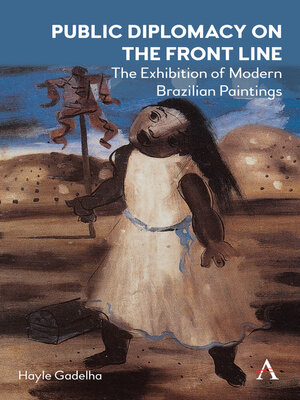Public Diplomacy on the Front Line
ebook ∣ The Exhibition of Modern Brazilian Paintings´
By Hayle Gadelha

Sign up to save your library
With an OverDrive account, you can save your favorite libraries for at-a-glance information about availability. Find out more about OverDrive accounts.
Find this title in Libby, the library reading app by OverDrive.



Search for a digital library with this title
Title found at these libraries:
| Library Name | Distance |
|---|---|
| Loading... |
The Exhibition of Modern Brazilian Paintings, held at the Royal Academy of Arts of London and seven other major venues throughout the United Kingdom in 1944 and 1945, was the first collective display of Brazil's art shown in the United Kingdom and the largest ever sent abroad until then. It resulted from an initiative championed by the Brazilian Foreign Ministry and envisioned by 70 Modernist painters who donated 168 artworks as a contribution to the Allied War effort. Notwithstanding its historical relevance and unmatched scale, this event had never been academically investigated. Through exploring why and how successfully the Brazilian government devoted superlative efforts to this enterprise in the midst of World War II, this book is intended to fill this gap and gain an understanding of a largely neglected public aspect of a deeply studied period of Brazilian foreign policy.
The research unearthed abundant firsthand documents to reconstruct the episode, adopting the hermeneutic method and a theoretical framework from the Public Diplomacy and Cultural Diplomacy fields in order to interpret the circumstances that made possible this improbable and challenging endeavor. It contends that the Exhibition was a remarkably innovative action of Public Diplomacy avant la lettre, which aimed at engaging with British society and enhancing the image of Brazil and its culture. Its motivations must be understood within the broader foreign policy, focused on obtaining prestige and repositioning Brazil in the postwar international order, which encompassed the deployment of 25,000 troops to fight in Europe. The research further claims that the initiative was intended and managed to achieve a substantial impact on views about Brazil, by means of conveying a well-planned message.
|In the midst of World War II, the Exhibition of Modern Brazilian Paintings left Rio de Janeiro, crossed the Atlantic Ocean, and arrived in London. The Exhibition resulted from a donation of 168 artworks by 70 of the most recognized Brazilian Modernist painters, including Tarsila do Amaral, Candido Portinari, Emiliano Di Cavalcanti, and Lasar Segall. The largest collection sent abroad until that time, and still today the most remarkable show of Brazilian art ever displayed in the United Kingdom, was held firstly at the Royal Academy of Arts in London, in the end of 1944, and subsequently toured throughout other seven British galleries until September 1945. As a contribution to the Allied war effort, the funds from its sales were given to the Royal Air Force. It is noteworthy that the Olympic Games planned to be held in London during the 1944 summer were cancelled due to World War II, but a show of unknown paintings from Brazil reached the British capital and was hosted by its most traditional art institution. Notwithstanding its historical relevance and unmatched scale, this event had never been academically investigated.
Even though it was publicized as private entrepreneurship, the dissertation proves that the Brazilian foreign service was the main propelling force of the Exhibition and addresses two fundamental questions regarding the episode. In the first place, why did the Brazilian government back a logistically complicated, politically delicate, and time-consuming idea of sending artworks to be displayed in the United Kingdom during the War? Second, how successful was the Exhibition in view of its original goals, specifically those set by Brazilian diplomacy? Conducted by a career diplomat who practices Public Diplomacy, the research pursued, by applying the hermeneutic method and theories of this field and its subset Cultural Diplomacy, to interpret the reconstructed and...







